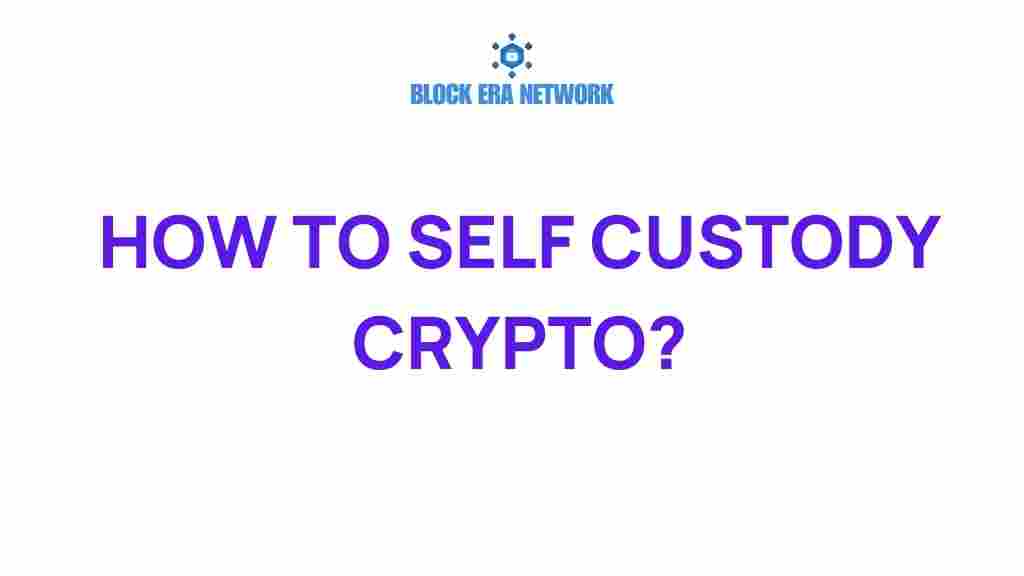Unlocking the Secrets of Self-Custody Crypto
As the world of cryptocurrency continues to evolve, investors are increasingly looking towards self-custody as a viable option for managing their digital assets. With the rise of decentralized finance (DeFi) and the growing importance of security in the crypto space, understanding self-custody is essential for anyone looking to invest in cryptocurrency. This guide will provide insights into self-custody, the types of wallets available, investment strategies, and tips for effective crypto management.
What is Self-Custody?
Self-custody refers to the practice of individuals holding and managing their own cryptocurrency without relying on third-party services or exchanges. This method allows investors greater control over their digital assets, reducing the risks associated with centralized platforms. By using self-custody, investors can enhance their security and privacy while participating in the broader blockchain ecosystem.
Benefits of Self-Custody
- Control: You have full control over your cryptocurrency and digital assets.
- Security: Reduces the risk of hacks and fraud associated with exchanges.
- Privacy: Limits the amount of personal information shared with third parties.
- Accessibility: Enables access to your funds anytime, anywhere.
Types of Cryptocurrency Wallets
When considering self-custody, it’s essential to understand the different types of wallets available. Each type has its own advantages and disadvantages depending on the security needs and investment strategies of the user.
1. Hardware Wallets
Hardware wallets are physical devices that securely store your private keys offline. They are considered one of the safest options for self-custody.
- Pros: High security, resistant to malware, and ideal for long-term storage.
- Cons: Can be costly and less convenient for everyday transactions.
2. Software Wallets
Software wallets are applications or software programs that manage your cryptocurrency. They can be further divided into desktop, mobile, and web wallets.
- Pros: Easy to use, quick access to funds, and suitable for frequent transactions.
- Cons: More vulnerable to hacks and malware compared to hardware wallets.
3. Paper Wallets
A paper wallet involves printing your private keys and public addresses on a physical piece of paper, providing a completely offline method of storage.
- Pros: Immune to online threats, simple to create.
- Cons: Risk of physical loss or damage, not user-friendly for transactions.
Setting Up Your Self-Custody Wallet
Now that you understand the types of wallets available, here’s a step-by-step process to set up your self-custody wallet:
Step 1: Choose the Right Wallet
Based on your investment strategies and security needs, select a wallet type that suits you best. For long-term holding, a hardware wallet may be ideal. For active trading, consider a software wallet.
Step 2: Download or Purchase the Wallet
If you’re opting for a software wallet, download it from the official website. For hardware wallets, purchase from a reputable source to avoid counterfeit devices.
Step 3: Install and Set Up the Wallet
Follow the installation instructions provided by the wallet service. For software wallets, create a new wallet and write down the recovery seed phrase provided during setup. This is crucial for recovering your funds if you lose access to your wallet.
Step 4: Fund Your Wallet
Transfer your cryptocurrency from an exchange or another wallet to your self-custody wallet. Always double-check the wallet address before sending funds.
Step 5: Secure Your Wallet
Enable two-factor authentication (2FA) if available. For hardware wallets, keep the device in a safe place. For software wallets, back up your recovery seed phrase and ensure your device is secure.
Investment Strategies in Self-Custody
Investing in cryptocurrency requires careful consideration of your strategies. Here are some effective investment strategies when utilizing self-custody:
1. Diversification
Diversifying your portfolio can mitigate risks. Invest in a range of cryptocurrencies rather than putting all your funds into one asset.
2. Long-Term Holding (HODLing)
Consider holding your assets long-term, particularly if you believe in the future potential of certain cryptocurrencies. This strategy can help avoid short-term market volatility.
3. Active Trading
If you’re comfortable with market fluctuations, consider trading actively. Utilize software wallets for quick access to your funds when executing trades.
4. Staying Informed
Stay updated with the latest trends and news in the cryptocurrency market. Following credible sources and participating in online communities can provide valuable insights.
Security Best Practices for Self-Custody
Ensuring the security of your self-custody wallet is paramount. Here are some best practices to follow:
- Use Strong Passwords: Create complex passwords and change them regularly.
- Enable Two-Factor Authentication: This adds an extra layer of security to your wallet.
- Keep Software Updated: Regularly update your wallet software to protect against vulnerabilities.
- Be Wary of Phishing: Always verify the sources of links and emails related to your wallet.
Troubleshooting Common Issues
Even with the best preparations, issues may arise. Here are some common problems and their solutions:
Problem: Unable to Access Wallet
If you can’t access your wallet, ensure you are using the correct password and recovery seed phrase. If you’re using a hardware wallet, ensure it’s properly connected.
Problem: Transaction Delays
Transaction delays can occur due to network congestion. Check the current network status and consider increasing your transaction fee for faster processing.
Problem: Lost Recovery Seed
If you lose your recovery seed, recovery may be impossible. Always keep multiple secure copies in different locations.
Conclusion
Self-custody of cryptocurrency offers investors unparalleled control and security over their digital assets. By understanding the different types of wallets, following best practices for security, and implementing effective investment strategies, you can confidently manage your cryptocurrency portfolio. As the landscape of decentralized finance (DeFi) continues to grow, embracing self-custody can not only safeguard your investments but also empower you to participate fully in the blockchain revolution.
For more detailed information on cryptocurrency management, check out our comprehensive guide on crypto wallets and security.
Additionally, for further reading on the latest trends in decentralized finance, visit DeFi Pulse for insights and updates.
This article is in the category Crypto Security and created by Block Era Network Team
